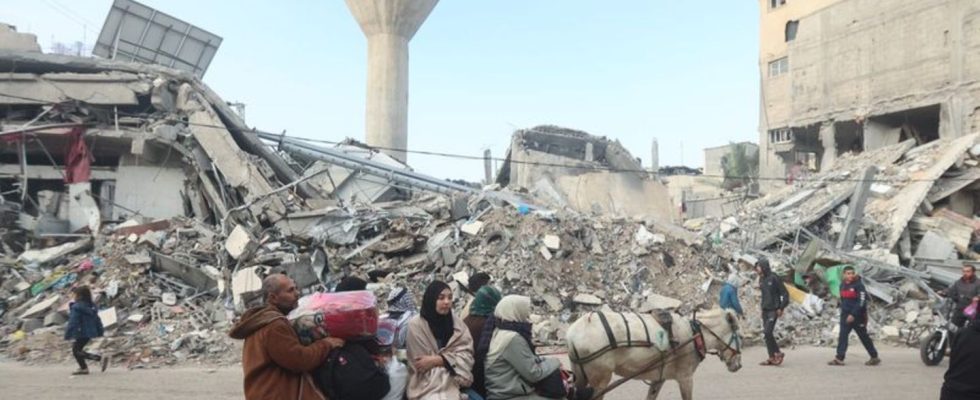Israel continues its heavy bombardment in the Gaza Strip. In the southern part, where most civilians have fled, fear and hopelessness reign. Aid organizations are horrified.
Israel’s massive bombing of southern Gaza, where much of the Palestinian civilian population seeks refuge in confined spaces, has sparked horror and outrage among aid groups. “Hundreds and hundreds of explosions. In a place so densely populated with civilians, everything has to hit something…someone,” UN Children’s Fund Unicef spokesman James Elder wrote on X (formerly Twitter) on Saturday. Hiba Tibi, director of the aid organization Care, told CNN about the situation of civilians: “They don’t know where to go.” There are no sufficient places to accommodate people.
According to the health authority in Gaza, which is controlled by the Islamist Hamas, the number of Palestinians killed by Israel’s bombing since the start of the war has now risen to more than 15,000. The majority of victims are women, children and young people. The authority’s information cannot currently be independently verified.
50 trucks with relief supplies
Meanwhile, according to the Palestinian Red Crescent, 50 trucks carrying aid supplies arrived in Gaza again on Saturday. The trucks were loaded with food, water, medical supplies and medicine. After the ceasefire ended and the fighting continued on Friday morning, aid deliveries came to a standstill.
Unicef spokesman Elder described Saturday night, in which Israel’s army said it had bombed more than 50 targets in the area of the city of Khan Yunis in the south of the sealed-off Gaza Strip alone, as “relentless.”
Care Director Tibi demanded: “We must protect the civilian population and the vital infrastructure on which they depend.” The Islamist Hamas hostages remaining in the Gaza Strip must be released immediately and unconditionally. “We need a humanitarian ceasefire,” Tibi said. “The fighting must stop.”
Increased bombardment in Gaza
Israel’s military stepped up its bombardment of targets in Gaza on the second day after a week-long ceasefire expired. “My children had recovered somewhat in the week after the bombing and fighting stopped,” said 38-year-old Samira Zaid. Now the state of “fear, unrest and destruction” is returning. During the ceasefire it was hardly possible to get cooking gas, says Machmoud Badawi. “It’s incredible that in the 21st century we have to cook our meals over wood fires.” Now even firewood is no longer available.
“We woke up to the explosions and knew the nightmare that we hoped was over has returned,” said Marsuk, who fled the north and lives in a refugee camp in the south. “The children, women and men in Gaza are terrified. They have nowhere to go to safety and have very little to survive. They live in the midst of disease, destruction and death. This is unacceptable,” said the head of the UN emergency fund, Martin Griffiths. “What can we do if we have nothing in our hands? We can’t stop Hamas, and we can’t stop Israel either. What’s happening here is madness,” Marsuk said.
Criticism of new evacuation map
The Israeli army on Saturday began using a new evacuation map that divides the Gaza Strip into hundreds of small zones to notify Palestinian civilians of active combat zones. People from several blocks were asked to flee to other districts in the northern Gaza Strip. In the south, Palestinians in several areas near the Israeli border were also asked to go to shelters in Rafah.
The map makes it “very difficult and frightening for people to know that they have to be evacuated for the sixth or seventh time,” complained Care Director Tibi on Saturday. The safe locations identified on the map would refer to United Nations designated centers. But they are already “extremely overcrowded”. People have to sleep outside, says Tibi.
Without electricity and internet, no card
A reporter from the Arabic television station Al-Jazeera reported from the Gaza Strip that many people did not have electricity or internet to view the Israeli map. The map confuses people and they don’t know how to deal with it. Furthermore, people did not trust the Israeli armed forces. They would have the feeling that no place in the Gaza Strip is safe.
Gaza resident Muneer Haduka believes that, in addition to Israel, the Islamist Hamas, which violently seized control of the coastal strip in 2007, is also responsible. “Both parties have made us displaced and beggars in our own country, without shelter or food,” says the 33-year-old Palestinian. The end of the ceasefire means the continuation of “this unacceptable situation”. Hamas had “committed a serious mistake against us,” said Haduka. However, Israel is not fighting Hamas, but rather punishing the people in the Gaza Strip collectively.
The latest Gaza war was triggered by the worst massacre in Israel’s history, which terrorists from the Gaza Strip committed in Israel near the border on October 7th. More than 1,200 people were killed. Around 240 hostages were taken to Gaza. Israel responded with massive airstrikes, a blockade of the Gaza Strip and began a ground offensive in late October.

